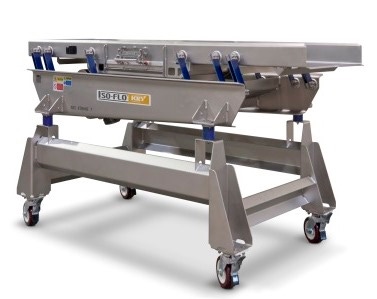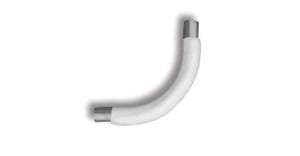February 23, 2015

Food processors around the world are looking to improve equipment hygiene. Some are motivated by new government guidelines or the desire to reduce exposure to product liability claims. Others want to improve manufacturing efficiencies by speeding sanitation routines or maximize food safety, knowing the most effective way to reduce the risk of product contamination is through prevention. For these reasons, conveyors are being scrutinized in their ability to contribute to or undermine sanitation initiatives.
This article will consider many conveyor design features that can improve hygiene and sanitation. It will discuss belt conveyors, bucket conveyors, vibratory shakers, and horizontal motion shakers, which are used to transport bulk foods. The objective is to help food processors understand what equipment features impact sanitation so they can better select the ideal conveyors to achieve their goals.
Design & Construction
Many sanitary features can be applied to multiple conveyors types. For example, stainless steel is the preferred material for food-grade conveyors more than coated mild steel because stainless resists bacterial growth and better withstands caustic washdowns. Three sixteen stainless steel provides better corrosion resistance than 304, which is important for acidic foods or processes.
The surface finish of the stainless steel also impacts hygiene with a smoother surface resisting bacterial attachment and the accumulation of bacterial cells. Compared to the industry-standard 2B mill finish, a rotary polish offers a more consistently smooth finish to improve sanitation to maximize food safety.
At a minimum, stainless steel and a rotary polish should be considered within a conveyor’s product contact zones. Extending the use of stainless to areas not in direct contact with food - such as the conveyor’s support structure - improves hygiene since bacteria can migrate from one area to another. Having ground and polished stainless steel within the “drip, drain, or draw zones” where it is possible for a pathogen to drip or drain or be drawn into the product area further enhances food safety.
All product contact zones should feature 100 percent continuous welds, rather than skip welds, to eliminate laminations that can harbor bacteria. TIG welds are better than MIG welds and ground and polished welds within the product contact zone are currently the ideal. Outside the product contact zone, replacing bolted arm brackets with welded arm brackets or eliminating skip welded exterior surfaces in favor of continuously welded surfaces, achieves additional protection.
The most hygienic conveyors feature no enclosed hollow bodies that could harbor bacteria and leak. Hollow bodies such as tubes, which have traditionally been used on conveyor frames, are increasingly being replaced by open-section supports made of plate or formed sheet metal. Conveyors designed with free draining surfaces, with even the conveyor bed at enough of a slope to drain, minimize the build-up of moisture during production and eases washdown.
Microorganisms are not the only source of potential product contamination that food processors must concern themselves with controlling in their efforts to improve food safety. Equipment suppliers are increasingly eliminating the stickers traditionally used to identify the machine or machine specifications because stickers can come off after repeated exposure to washdowns. At a minimum, stickers should be metalized so any pieces that find their way into the product can be detected and removed by end-of-line metal detectors. Even plaques are prone to problems because the lamination can trap bacteria if a weld fails. Ideal solutions include attaching plaques with stand-offs or spacers or etching the information directly onto the stainless steel equipment.
Another potential source of contamination is oil from drives, especially when equipment is mounted over other equipment. Currently, conveyor drives can be designed for use with food-grade oil but the move to oil-free drives, where possible, is underway. Inherent in their nature, electromagnetic vibratory conveyors are always oil-free. Now, popular natural frequency vibratory conveyors, which have mechanical drives, are being developed with oil-free electric vibrating motors to eliminate the gear box, drive belts and motor oil from the process. Since these natural frequency vibratory conveyors can be built to grade, dewater, deoil, align, feed, and accomplish many other processes while conveying, the opportunity to improve equipment hygiene with this shift to oil-free drives is substantial.
To improve worker safety and ease sanitation, many customers are pursuing “dry floor initiatives.” They are looking for conveyors with leak-free screens and screen clamps. Quality-minded conveyor suppliers are continuously improving their designs to minimize water leakage and product spillage, especially at equipment transitions where product spillage is a common problem.
Food processors require different degrees of sanitation, with meat and dairy processors often relying on the most stringent high pressure washdowns that use caustic cleaning agents that minimize the risk of bacterial growth. To withstand high pressure washdowns, the equipment should feature NEMA 4X- or IP 66-rated electrical enclosures and components while wipe-down sanitation routines demand less water ingress protection.
Clean-in-place (CIP) systems are common on many food-grade conveyors, but they are also being scrutinized as a potential source of bacterial contamination. CIP systems introduce additional pipes and additional pipe threads where bacteria can grow. For this reason, it is now understood that effective manual sanitation routines are often better than CIP systems and that CIP systems should be limited to areas that cannot be accessed by the sanitation crew, such as conveyors high in the air.
Belt and Bucket Conveyors
In addition to the design and construction features mentioned above, many of which can be applied to belt conveyors as well as vibratory and horizontal motion conveyors, a variety of other considerations apply only to belt and bucket conveyors.
In general, fabric belt conveyors with exposed belt edges present the least sanitary environment because the belt can fray and contaminate the product. Fabric belts with encapsulated edges are preferred and may be a more sanitary solution than modular plastic belt conveyors, which feature crevices that can trap bacteria and are time-consuming to clean.
The most hygienic and sanitary type of belt conveyor features a positive drive urethane (PDU) belt. This seamless homogeneous thermoplastic belt eliminates the frayed edges of a fabric belt and the many crevices of a modular plastic belt. Unlike traditional flat belt conveyors, PDU systems drive their belts on sprockets like a modular plastic belt conveyor and are not under tension, which allows for easy lifting of the conveyor belt for relatively fast and thorough cleaning.
For applications that require elevating product, modular plastic belts and PDU conveyors can both be designed with flights. Compared to traditional bucket conveyors, which run on two chains that inherently challenge sanitation, processors can achieve the same rise in elevation with a PDU conveyor and improve sanitation. However, modular plastic belt conveyors and PDU conveyors are unable to change directions, moving in a C-shaped path like bucket elevators can, so processors that require this motion will either need a bucket elevator or alter their line configuration to accommodate that limitation.
Vibratory and Horizontal Motion Conveyors
Vibratory conveyors are widely recognized as being inherently more sanitary than belt conveyors, all else equal, because they minimize product contact with moving parts and present a flat-bed surface that is easy to clean. Horizontal motion conveyors further improve sanitation because product slides along the bed, producing a self-scrubbing action that eliminates the build-up of seasonings that can break off.
The most sanitary vibratory and horizontal motion conveyors feature as many of the design and construction attributes mentioned above as are possible. Not every conveyor type can accommodate every feature. For example, open-section supports and oil-free drives can be used on vibratory conveyors but are not possible on horizontal motion conveyors due to engineering constraints.
Conclusion
Increasingly, food processors around the world are searching for more hygienic and sanitary equipment. In addition to it being a good business practice to produce foods that are safe to consume, many also understand that improving hygiene can improve profitability. Reducing the time it takes to clean can reduce sanitation labor costs and increase production line uptime while resulting in less water use, less chemical use, and less waste water that needs treatment.
Most conveyor suppliers offer a variety of equipment that has been designed to satisfy various levels of standards from basic to enhanced. Recognizing that different suppliers include different features in their various models – that not all basic features are the same and not all enhanced features are the same – it behooves a food processor to understand what makes a conveyor more or less sanitary so they can better compare options and make the ideal selection given their applications and objectives.
Peter Wood is process systems product manager at Key Technology Inc., Walla Walla, WA. For more information, call 509-529-2161 or visit www.key.net.
For related articles, news, and equipment reviews, visit our Mechanical Conveying Equipment Zone
You May Also Like


